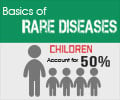The recently submitted national rare disease policy 2017 has serious flaws and gaps which need to be addressed before finalizing the policy document.
- In 2016, the High Court of Delhi directed the Ministry of Health and Family Welfare to frame a “national policy on treatment of rare diseases”
- This directive was the result of 3 petitions in 2013 and 2016 from patients with Gaucher and Pompe disease for providing free Enzyme Replacement Therapy (ERT)
- Unfortunately the policy which evolved has turned out to be a narrow, skewed policy focusing primarily on ERTs for Lysosomal Storage Disorders (LSDs)
- Such a policy cannot claim to be under the overarching umbrella of “rare diseases” since it primarily focuses only on one rare disease group
- A fair and just policy needs to take into account all existing rare diseases in India and scope for their treatment and possible cures
According to the Indian Organization of Rare Diseases, India has a population of nearly 100 million people with rare diseases; yet the national policy has taken a skewed position with all three government-appointed sub-committees solely focusing on ERTs for the treatment of LSDs. The VK Paul Sub-Committee report, the IC Verma Sub-Committee report and the DK Tempe Sub-Committee report have singularly focused on LSDs treatment. It is odd that only ERT which is the treatment for just one group of rare diseases should be the sole focus of a national umbrella policy on rare diseases. Both the IC Verma and DK Tempe Sub-Committee report have evaluated the costs of ERTs for a range of LSDs including Pompe, Gaucher, Fabry’s, MPS I, MPS II, MPS IV and MPS VI.
According to the Lysosomal Storage Disorders Support Society (LSDSS), the frequency of LSDs in India is around 1 in 40,000. Let us compare this frequency with other rare diseases reported in India:
- A case report in the International Journal of Anatomy and Research (Mandal, Mandal & Kundu, 2015) indicates that Osteogenesis Imperfecta affects 1 in 20,000
- According to Indian Pediatrics, Duchenne Muscular Dystrophy which is the most common form of all dystrophies affects 1 in 3500 live male births
- The Indian Society for Primary Immune Deficiency estimates the number of affected patients at almost 1 million patients in India based on the prevalence of 1 in 2000
- Singhal and Advani (2015) estimate an approximate prevalence of 1.33 per 100,000 for Multiple Sclerosis in India
- According to Muthane (2008), the crude prevalence of Parkinson’s disease in India (epidemiological study in Kolkata) is around 45.8 in 100,000
- According to Abdul Latheef (2010), the prevalence of Inborn Errors of Metabolism (IEM) is 1 in 2497 newborns. Indian Pediatrics reveals that 2.1 per 1000 are born with congenital hypothyroidism
Gray Areas
- Measures towards identification, diagnosis and prevention of rare diseases
- Treatment and care approach is completely missing. The policy needs to include the support to be provided to rare disease communities including clinical services, rehabilitation and palliative care
- The policy does not say anything about creating specialist centers for rare diseases which can draw on existing facilities in various hospitals across India
- There is no mention of upgrading medical education and healthcare education to include rare diseases
- The policy again tilts only in one direction regarding drugs for rare diseases. The policy only elucidates import issues of ERTs for LSDs whereas a range of rare diseases require drugs which are imported
- No mention of clinical research and upgraded clinical trials policy to waive aside the regular route in clinical trials for rare diseases. Often people with rare diseases cannot wait until a newer therapeutic has gone through the regular route of phase 1, phase 2 and phase 3 clinical trials. In such cases, faster access to clinical trials can save many a life. The policy does not touch upon this aspect at all
The policy does not clearly outline an orphan drugs section which is critical towards creating better access to drugs and devices for rare diseases. The 1983 US Orphan Drug Act revolutionized the treatment of rare diseases by incentivizing the production of drugs for such conditions. If drugs and devices for rare diseases have to become cheaper, affordable and more accessible it is essential to provide such incentives to local pharma and drug manufacturers. Indigenous production of drugs and devices can save the lives of many patients who would otherwise not be able to afford expensive treatment. Apart from drugs and devices, dietary and nutritional supplements for rare diseases are also required and local production will again boost accessibility.
In order to truly serve the rare diseases communities in India, the policy has to adopt a more balanced, fair and inclusive approach to all rare diseases. Concentrating only on one group of rare diseases indicates a lop-sided approach which will serve only a few patients in the country. If the policy makers had truly adopted an evidence-based approach and at least collected preliminary epidemiological data on prevalence and incidence of documented rare diseases in India, the current policy would not be so skewed and narrow.
It is necessary to challenge this current policy and rethink the approach to include all existing, documented rare diseases in India so that no patient group is left in the lurch without adequate access to treatment and care.
The writer is thankful to Prof. Vijay Chandru, Chairman, Strand Life Sciences, Bangalore for his inputs on the policy gaps.
References:
- What is a Rare Disease? - (http://www.rarediseaseday.org/article/what-is-a-rare-disease)
- FAQs About Rare Diseases - (https://rarediseases.info.nih.gov/diseases/pages/31/faqs-about-rare-diseases)
- Ministry of Health and Family Welfare (2017). National Policy for Treatment of Rare Diseases
- Lysosomal Storage Disorders Suppor Society - (http://www.lsdss.org/)
- Welcome to I-ORD - (http://www.i-ord.org/)
- About PIDs - (http://www.ispid.org.in/About.aspx)
- Brittle Bones, Unbreakable Spirit: Osteogenesis - (https://www.ijmhr.org/ijar.3.1/IJAR.2015.107.pdf)
- Multiple sclerosis in India: An overview - (https://www.ncbi.nlm.nih.gov/pmc/articles/PMC4604693/)
- A database for inborn errors of metabolism in the Indian state of Andhra Pradesh - (https://www.ncbi.nlm.nih.gov/pmc/articles/PMC2957769/)
- Orphan Drug Act - Relevant Excerpts - (https://www.fda.gov/forindustry/developingproductsforrarediseasesconditions/howtoapplyfororphanproductdesignation/ucm364750.htm)












